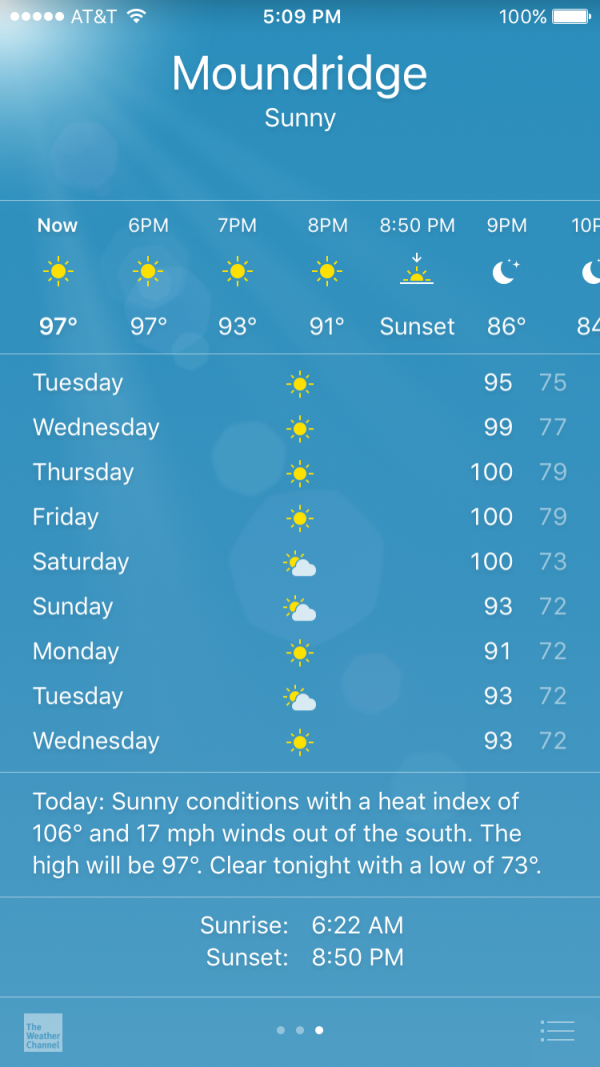Lawn Care Tip of the Month: Be water wise
Posted on:Jul 18, 2016
This is Part VII of our Lawn Care Tip of the Month blog series.
 Hello, Summer!
Hello, Summer!
Here in Kansas, we had a good run of periodic rain and sun through May and June, but all good things must come to an end, unfortunately. Looks like we’re set up for a hot, dry stretch, with little relief in sight, according to the extended forecast.
But, hey, we expect some heat in the summer on the plains, but all this hot weather can be a killer on the lawn...literally. That's why it's important to think wisely about how you water your lawn. The practices you put in place in summer can have lasting impacts on the long-term health of your turf.
You may not know it, but the Irrigation Association has named July Smart Irrigation Month. According to IA, Smart Irrigation Month, which first launched in 2005, is "gaining traction as stakeholders recognize the positive impact efficient irrigation and water use provides."
IA has some practical, helpful tips for homeowners, contractors, growers and other end-users to save money and water through water-saving technologies and practices. Here are a few of those tips, as shared on its Smart Irrigation Month website.
Plant Right
Saving water doesn’t have to involve the cost and inconvenience of tearing up your yard to install a new irrigation system. It’s easy to save water and reduce your utility bills with simple changes to your landscaping and gardening routine.
Landscape to suit your lot. Choose grass or plants that have low water requirements and will thrive in your local climate. Consider sun and shade, dry and damp areas, plant size, and how you plan to use each section of your yard.
Keep soil healthy. Aerating your lawn and around trees at least once a year helps improve water penetration. When planting, turn and cultivate the soil and add compost or fertilizer to improve moisture retention and grow healthier plants that need less water to stay strong.
Mulch well around plants, bushes and trees. Spreading two to four inches of mulch reduces evaporation, moderates spikes and lows in soil temperatures, improves water penetration and helps control weeds that compete for water.
“Hydro-zone” your yard. Grouping plants with similar moisture needs in the same area makes it easier to make sure they get the water they need without overwatering. Separate plants from grassy areas, which have different water requirements.
Plant in spring or fall. Avoid summer, when hotter temperatures mean plants need more water to become established.
Save grass for functional areas. Plant grass in play zones and other areas where it will be used and enjoyed. Consider ground cover, perimeter plants or mulch for slopes or other hard-to-water spaces instead of turf.
Plant shade trees. The shade they cast creates natural “air-conditioning,” lowering air and soil temperatures, and reducing soil moisture loss.
Maintain your yard regularly. A well-maintained yard requires less water, so weed, prune and mow as needed.
Water Wisely
Be sure to take advantage of the controls on your irrigation system and adjust the settings and timing to fit your lawn’s needs throughout the summer and beyond.
Get in the zone. Schedule each individual zone in your irrigation system to account for type of sprinkler, sun or shade exposure, and soil in that section. Different zones will almost always need different watering schedules.
Consider soil type. Type of soil determines how quickly water can be absorbed without runoff. Watering more than soil can absorb causes runoff and waste.
Don’t send water down the drain. Set sprinklers to water plants, not your driveway, sidewalk, patio or buildings.
Water only when needed. Saturate root zones and let the soil dry. Watering too much and too frequently results in shallow roots, weed growth, disease and fungus.
Water at the best time. Watering during the heat of the day may cause losses of up to 30 percent due to evaporation. Prevent water loss by watering when the sun is low or down, winds are calm and temperatures are cool — typically between the evening and early morning.
Water more often for shorter periods. For example, setting your system to run for three, 5-minute intervals lets soil absorb more water than watering for 15 minutes at one time, reducing runoff.
Adapt watering to the season. Familiarize yourself with the settings on your irrigation controller and adjust the watering schedule regularly based on seasonal weather conditions. Or invest in a smart controller so your system can make these changes automatically.
Tips courtesy of the Irrigation Association. http://www.irrigation.org/

